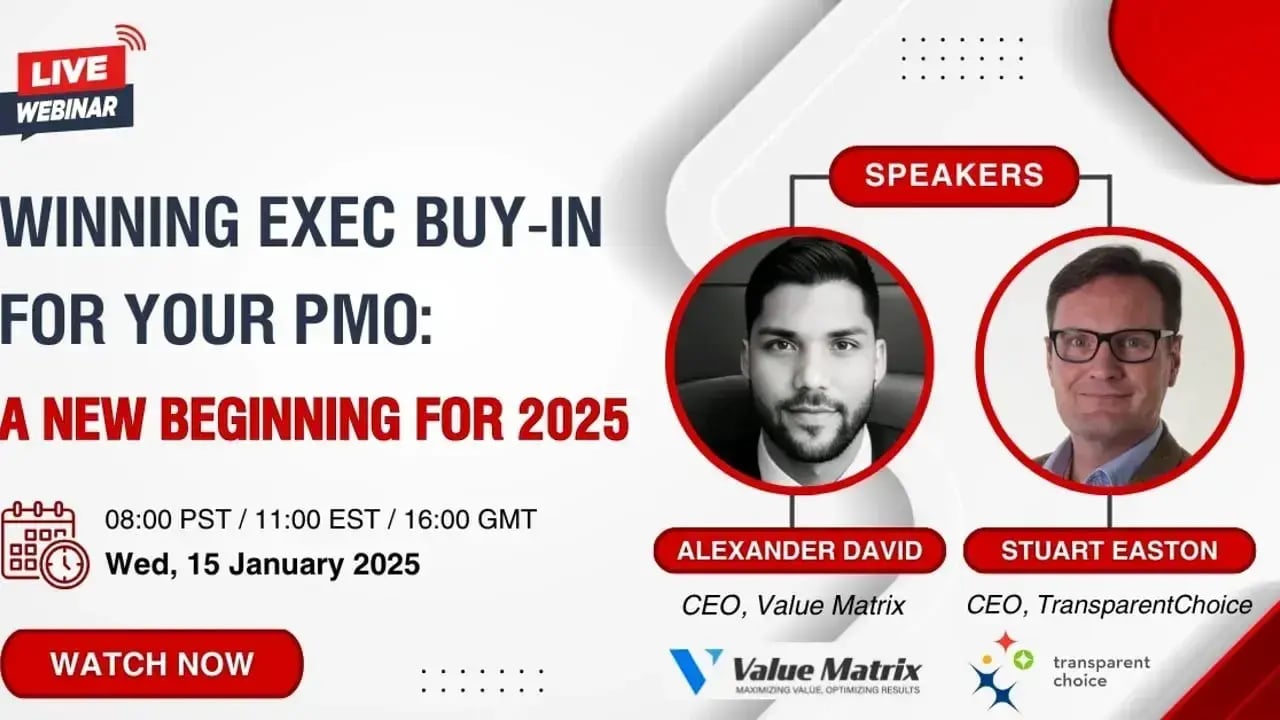Winning Executive Buy-in For Your PMO

Speakers

Alexander David is a strategic portfolio management and PMO leader with extensive experience in driving transformation, carve-outs, and change leadership. As CEO of Value Matrix, he helps organizations achieve operational excellence and sustainable growth through strategic planning, organizational transformation, and digital innovation.

Stuart helps PMO and portfolio leaders build strategy-aligned portfolios and prove ROI. A guest lecturer on project prioritization at the University of Oxford, he speaks widely on killing pet projects, focusing investment on value, and using decision science (AHP) to make clear, defensible choices.
About this webinar
Why don’t executives support the PMO? Why is it so hard to win sponsorship, resources, and real buy-in from the top? That’s the question explored in this session, recorded live from the PMI Dubai International Project Management Forum.
TransparentChoice CEO Stuart Easton is joined by Alexander David, CEO of Value Matrix and a seasoned PMO transformation leader, to unpack why executives often fail to “get” the PMO—and what you can do to change that.
The executive disconnect
Many executives view the PMO as overly focused on processes, tools, and reporting. What they really care about is value—outcomes such as increased revenue, strategic alignment, operational efficiency, and risk reduction. The challenge for PMO leaders is translating PMO activities into a language executives understand.
Common symptoms of poor buy-in
- Ignored PMO reports and dashboards
- Slow or delayed executive decision-making
- Projects prioritized based on individual interests rather than strategy
- Perception of the PMO as a cost center or bureaucratic hurdle
- Lack of resources or sponsorship to deliver real change
Breaking through: the Case for Change
Alexander introduces the concept of a Case for Change—a dynamic approach to winning executive support. Unlike a traditional business case, it identifies high-value pain points and addresses them in short, 90-day cycles. This agile method delivers quick wins, maintains executive engagement, and creates momentum for lasting transformation.
Addressing executive pain points
Three recurring challenges surfaced during the conversation:
- Lack of Visibility: Executives need clear insight into project status and strategic alignment.
- Weak Controls: Without governance, they struggle to see the PMO’s value in managing risk and benefits.
- Execution Gaps: Resource bottlenecks and inefficiencies undermine delivery and outcomes.
From cost center to strategic enabler
Ultimately, the PMO’s role is to act as a bridge between executive vision and operational execution. By listening actively, addressing real executive pain points, and delivering incremental value, the PMO can evolve from being seen as an administrative overhead into a trusted business partner that drives strategy, alignment, and transformation.